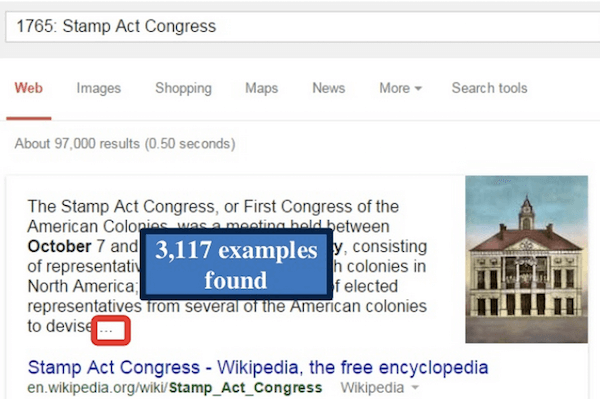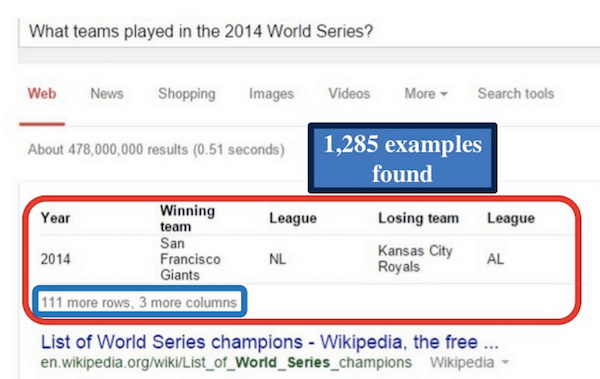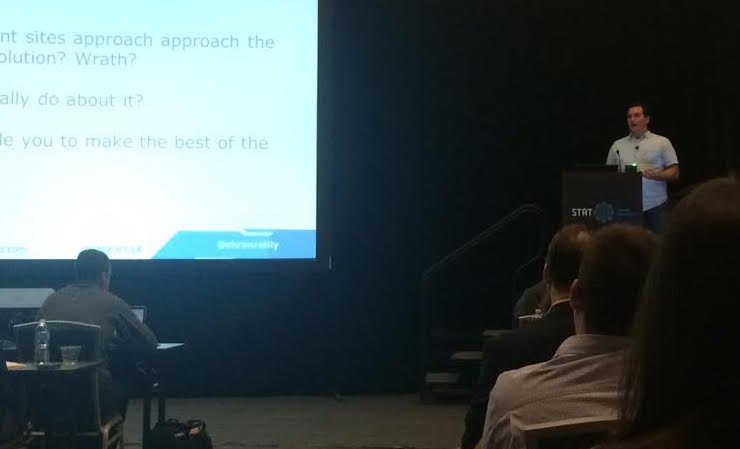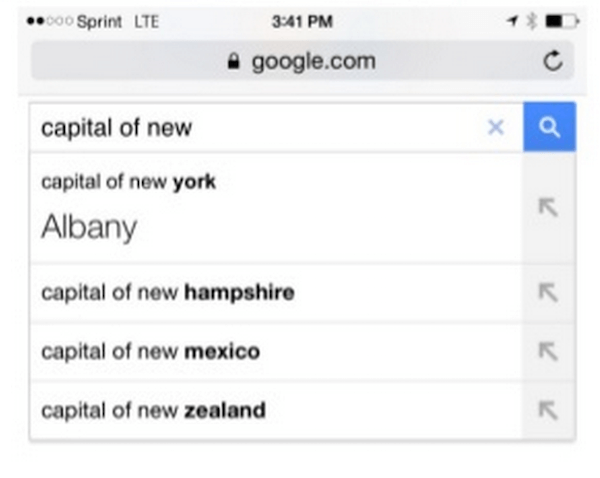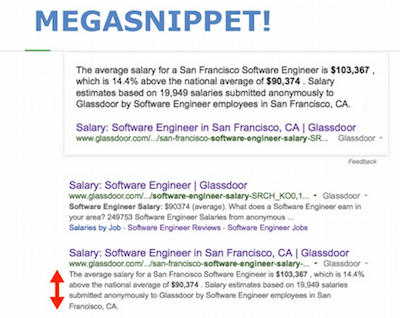The Growth Of Direct Answers: How Should SEOs React?
More and more often, SERPs are including answers, not just links to answers. Columnist Mark Traphagen recaps an SMX West panel that explores the effects.

Remember that annoying student when you were in school? The one who sat in the front row and raised his hand for every question before you could?
In the eyes of many site owners, Google has become that student.
For an increasing number of search queries requesting factual information Google (and to a lesser extent, Bing) is returning answers at the top of search results pages that (usually) don’t require any click-through by the searcher.
This could be seen as a serious threat to sites that have been accustomed to getting organic search traffic by providing that kind of information. In fact, SEO Glenn Gabe documented a dramatic drop in traffic for several song lyrics sites after Google started displaying lyrics as a direct answer.
However, other webmasters see Google’s direct answers in search as a new opportunity to get a jump on the competition and become featured for free by Google.
At this year’s SMX West conference in San Jose, three experts who have been keeping a very close eye on developments with Google’s direct answers reported their findings and provided advice as to what site owners can do to take best advantage of a search feature that will only continue to grow in its influence.
This post will give you the main ideas and takeaways from each of their talks. You will also find an embed of each speaker’s slide deck so you can get further detail and see their examples.
The panel:
Eric Enge, CEO of Stone Temple Consulting @stonetemple (full disclosure: my employer)
Bill Slawski, Director of Search Marketing for Go Fish Digital, @bill_slawski
Ehren Reilly, Director of Product, Growth at Glassdoor, @ehrenreilly
Eric Enge revealed findings from a recent study he conducted, while Bill Slawski provided a deep dive into possible sources for Google’s direct answers. Finally, Erhren Reilly shared some ways his company has been using direct answers to their advantage.
What’s New With Direct Answers In Search By Eric Enge
Eric Enge shared the results from a recent Stone Temple Consulting study that submitted over 850,000 questions to Google and Bing search to see how many yielded direct answers.
Direct answers or “rich answers” are a special result at the top of the first search results page that provides a brief answer to a question query that (in most cases) does not require a click through to a web site.
The questions were generated as follows:
- 250,000 each came from Google’s and Bing’s auto suggest features
- The rest were generated via brainstorming by the Stone Temple research team
For the latter set of question, the team compiled a huge list of persons, places, and things, and then generated various questions a real person might want to know about those things. For example, for “Eiffel Tower” questions used might include “when was the Eiffel Tower built?” and “where is the Eiffel Tower located?”
Their finding: Google returned direct answers 19.4% of the time. Bing provided them for 1.1% of the queries used.
Enge remarked that they saw a great variety of answer types, including tabbed menus and movie times.
He reported that in over 3000 cases, the direct answer was incomplete, with an ellipsis that links to the originating site. For example:
Over 1000 were in the form of a table, such as this one for World Series Winners:
Other types of rich answer boxes found in the study included:
- Linked tables (or “sliders”) – 6,740 results: search Google for “what time zone is Russia?” on a desktop browser and click one of the displayed time zones. Notice that a knowledge panel for that time zone opens in the right sidebar.
- List or step-by-step – 1,871 results: Search Google for “okra boiled” and you get a three-step recipe. By the way, all of the observed examples of this type linked to a third-party source. In many of these some of the steps themselves were incomplete, with a linked ellipsis, or a “more items” link at the bottom.
- Rich answer box plus a sidebar knowledge panel – 45,132 results: Search Google for “who is Rin Tin Tin?”
- A form – 5,356 results: Try “how many calories in a pepperoni pizza” or “mortgage calculator.”
- Charts – 33 results: Try “GDP of the USA.”
- Carousel – 4,284 results: Try “roster for the boston red sox.”
- Link to follow on actions – 172 results: These rich answer boxes included a direct link to a resource, such as an app download. Try searching “youtube account maker.”
- Image in result – 36,392 results: Try “when will Jupiter Ascending be released?”
- Related items shown: These results include a bar with thumbnail image links to searches that are related to the current search. For an example, try searching “capacity of allstate arena.”
Enge said about 75% of the direct answer boxes viewed in the study included attribution links to the original source. Example of types that didn’t included song lyrics and public domain info (such as “What is the capital of Washington state?”). A Google representative told Eric that Google only shows song lyrics for songs for which they have obtained proper rights.
Enge concluded with some thoughts about the potential impact of these direct answers on publishers:
- Don’t try to make a living on public domain info
- Even licensed info is vulnerable (e.g., song lyrics)
- Could be good if your site is selected for a partial answer with a link, which might actually drive traffic to your site
Eric Enge’s slide deck for this presentation:
https://www.slideshare.net/SearchMarketingExpo/whats-new-with-direct-answers-in-search
The Growth of Direct Answers: How Should SEOs Evolve? By Bill Slawski
Are query results better if Google provides a direct answer in addition to the regular results? Bill Slawski opened with this question. He noted that providing direct answers was listed as a positive in Google’s Q4 earning statement.
Google claimed that providing such answers “makes it quicker, easier, and more natural to find what you’re looking for.” Google Chairman Eric Schmidt, in “We Built Google for users, Not Websites,” stated that Google would be providing more or these direct answers because “it’s quicker and less hassle than the ten blue links” Google has traditionally shown.
Slawski also referenced a patent filed by Google Israel last year, titled “Natural Language Search Results for Intent Queries.” He found it interesting how the patent authors determined authoritative sources. In particular they cited as authoritative pages which:
- were frequently selected in search results
- consistently rank high in search results for related topics
The Israeli researchers built templates with different forms of the same question. They then looked for pages that consistently rank higher for all those forms. High ranking pages were put into a data store, listed by headings (such as “What are the symptoms of Mono?”) and answers (the concise list of symptoms).
What are the potential benefits of having your content appear as a direct answer? Slawski listed three:
- Additional chance to be seen in search.
- Opportunity to be seen as authoritative (since Google picked you as the best answer).
- The different formatting of the answer box compared to the rest of the results is sure to bring more eyes to the result.
Slawski drew from another Google research paper to come up with some possible sources for authoritative answers:
- Tabular data (example: a Wikipedia info box alongside a Wiki article)
- Relational tables that display related data in tabular format (such as a list of U.S. Presidents and basic facts about each)
- Colon-delimited pairs (such as “Check In Time: 3:00 PM; Check Out Time: 12 Noon” for a hotel)
- Structured snippets
- Knowledge bases
- Query stream data merged with knowledge bases and web documents (Biperpedia)
Some facts are just in the Knowledge Graph and need no attribution (“How old is Barack Obama?”), while others come from specific sources.
In some cases, it appears Google may actually reach out directly to trusted sources to gain information. For example, Google recently announced a partnership with reliable health sources such as the Mayo Clinic to obtain answers from real human experts, which are now being passed along for selected health-related queries as direct answers.
Bill Slawski’s slide deck for this presentation:
https://www.slideshare.net/SearchMarketingExpo/the-growth-of-direct-answers-how-should-se-os-evolve
Winning With Direct Answers As A Content Site By Ehren Reilly
Reilly began by allaying fears site owners might have about publishing question-answer type content, namely that such content is “thin” and therefore could bring on a Panda penalty. But Reilly claimed that Panda is not really about thin content, at last not in the sense of the length of the content. Panda, he said, is more about quality. So content can be high quality but bite-sized.
However, many sites have tried to drive traffic by merely providing quick question-and-answer type information. That alone won’t work so well anymore. Google realized people want such info as quickly as possible, so why make them click through to a site for it?
So as more and more of those questions get answered by Google direct answer boxes, it is no longer a viable business model just to supply high quality but bite-sized information. Sites like isitraining.org or whatsmyipaddress.org are becoming superfluous.
Another endangered species, according to Reilly, is what he called “high quality, non-proprietary content.” This is content that is highly valued by searchers, but is either public domain information or easily-obtained licensed information. He gave examples of song lyrics, information available in Wikipedia or other public knowledge bases, or simple facts already in Google’s Knowledge Graph.
Sometimes Google even provides answers directly in the query box auto suggestions!
But what if you have high quality, proprietary content? Is that safe from Google’s direct answers?
Even that type of content can be threatened by direct answers. Google may show what Reilly called “spoiler alert” results.
In the example above, Google grabs one fact snippet out of a much longer piece (a complete recipe) to answer a question.
The above examples make many publishers feel like Google is stealing their content. But according to Reilly, Google’s response would be that they are just doing what’s best for the user.
So what can publishers do?
Reilly said you should consider that getting your content in a direct answer box is good branding. The top organic result isn’t always the one shown in the direct answer box, so earning that place could be considered a win for a lower-ranking site.
Reilly provided an example of such a win achieved by his company, Glassdoor. They publish salary info for various jobs, which started showing up in direct answers. The problem was that while the information was theirs, from a report that took a large investment to produce, Google was showing in the answer box data and attributions from other publishers writing about their report.
They analyzed their page in comparison to those that were getting the answer box, and determined that the other publishers had a sentence that clearly and directly answered the questions, while theirs didn’t. They altered their page to include such sentences, and very quickly they began showing up in the answer boxes.
Takeaway: Make sure you have clear, natural language in your articles that directly answers the most likely questions about any factual information.
Reilly shared another benefit they discovered: when you get in an answer box, your regular result gets a fatter snippet with the same answer text. You get more search results real estate.
Every direct answer follows a formula. If you look carefully at the pages that get into direct answers for information your site provides, you’ll see the pattern. Find it for your pages and structure your content accordingly.
What about clicks? Webmasters are concerned about whether direct answer boxes result in click-throughs to their sites.
The classic search problem was getting more clicks than your competitors. But now it is more like getting a click vs. no click at all!
Some direct answers entice clicks better than others. For example, a list or step-by-step answer box which has abbreviated steps with an ellipsis link at the end, or an incomplete set of instructions with a “more info” link.
How do you earn those? Create large or exhaustive lists that Google can’t fit completely in an answer box.
Another trick Reilly shared is to provide teaser text right after your direct answer that hints there is more the reader would want to know. Chances are that text will get included in the direct answer, thereby enticing a click through.
What about rank tracking? Be aware that if there are direct answers, your ranking results may be thrown off. Some rank tracking software doesn’t handle direct answers well, counting them as one of the organic results, or even as the top several.
Reilly cautioned that we should expect flux. Direct answers are still new. Google is constantly testing new formats, and there are errors to be fixed.
If you’re a publisher, get over your frustration and see this as a new opportunity.
Ehren Reilly’s slide deck from his presentation:
https://www.slideshare.net/SearchMarketingExpo/how-to-win-with-direct-answers-as-a-content-site
Some Tidbits From The Q&A
- For Glassdoor, being in direct answers proved to be more beneficial than being #1 in regular result under a direct answer that used someone else’s site.
- Enge noted that Google seems to respond more often with a direct answer when you make a voice query as opposed to a typed query on mobile.
- Reilly said that direct answers give new life to FAQs. You can now rank for an individual answer on an FAQ page.
- Danny Sullivan noted that even searching “Zillow mortgage calculator” now returns the Google mortgage calculator. So even branding your generic info is not an advantage. However, he said that we should remember that after Yelp complained loudly when Google showed Google reviews even when queries specified Yelp reviews, the Google reviews for such queries disappeared after the Pigeon update. So it may be possible for powerful brands to reclaim their branded info-content.
Contributing authors are invited to create content for Search Engine Land and are chosen for their expertise and contribution to the search community. Our contributors work under the oversight of the editorial staff and contributions are checked for quality and relevance to our readers. The opinions they express are their own.
Related stories
New on Search Engine Land

